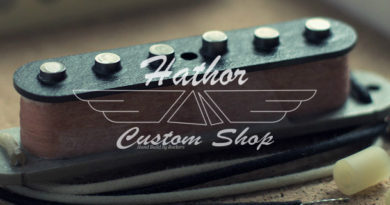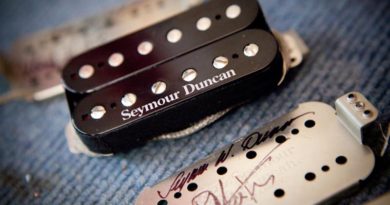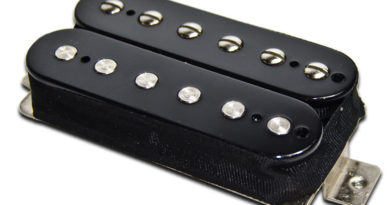DiMarzio Mirage Humbucker Set
The news of the Mirage set is something that makes me look forward to New Pickup Day. How so? It’s no secret that I’m a fan of Jake Bowen’s prior signature models. The Titan (for 6 string guitars) and the Titan 7 (for, you guessed it, 7 string guitars). The Mirage is for the 6 string players, but we can always hope for the extended option. Especially if it’s as cool as the one we are talking about here today.
What’s going on with the Mirage set? How about we take a look?
The most obvious thing is that the neck position is a single-width rail-style humbucker. Single-space humbuckers can be a tricky affair, so I’m naturally interested in hearing how this one sticks the landing.
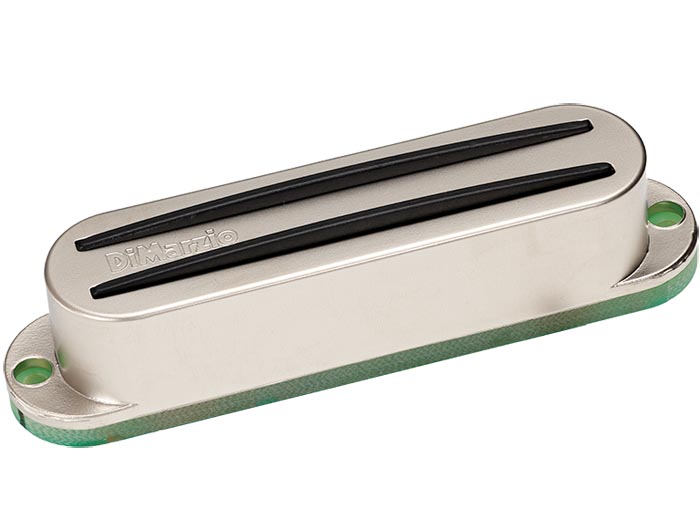
Installation
This set is going in to the Mirage Deluxe ’87. Alright! I know what you’re thinking! LOL! The guitar model name is a coincidence and totally about the hum-single configuration. Guitar specs are: Alder body. Maple neck with 25-1/2″ scale ebony board. Jake’s new Ibanez is basswood with an 25-1/2″ ebony board and similar pickup route. I think we got it matched up as close as can be. HaHa! The tuning is E standard with 09-42 strings.
The harness has a CTS 500k pot with a 15% taper and an Oak Grigsby 5-way Super Switch. Hold up there, hotshot! What’s that Super Switch about? LOL! Glad you asked. That is what Jake is using for this setup in his guitar, so I’m rolling with it. HaHa! And DiMarzio is kind enough to provide the Wiring Diagram, so it’s a no-brainer.
The result is as follows: Bridge, series. Bridge and Neck, split to inner coils. Middle position is Neck and Bridge, series. Neck, parallel. Neck, series. This is a great setup for a 2-hum guitar for incredible versatility. This is the stock configuration in the old Charvel Predator I’ve had since new and I’m thrilled to expand it to this Mirage Deluxe. You will see some examples in the Mirage demo video here in a minute.
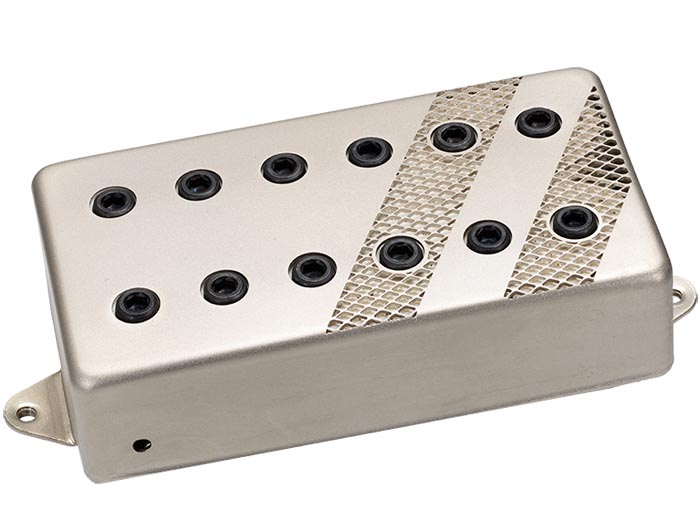
Evaluation
Hands down, this is a great pickup set. If you like the Titan set, but want a little more headroom and transparency, here you go. In the same tradition, the Mirage set is so much more than any association to a style of music. Not in to djent or metalcore? That truly does not matter with this pickup set. The DNA of this tone is engineered to do so many things, as is the sonic landscape that Jake has to cover within the realm of his band.
The Mirage Bridge
Yes, it has a little more output. In some instances, more output can translate into a heavier vibe and a more compressed voice. That is definitely not the case here. With the Mirage bridge, it’s actually more clear and more palpable. The mids are pushed forward ever so slightly, in as much as to help firm up the lows and fortify the highs. I do like me plenty of midrange, however this is in moderation for the purpose of enhancing the dynamics.
Of course you can expect me to be hitting the riffs with this bad boy. Pedal note style chugging has presence, yet remains firmly precise. There is heft without the boom or the mud. And if you like more than basic power chords, the more complex fingerings deliver peppy and effective vitality.
The nature of the voicing make it very touch sensitive and prone to the nuances of the left hand. When rolled back a little, the natural decay is musical and harmonically rich. And I’m very much liking the voicing as a set. Even without the extra levels of options from the Super Switch, switching positions is a smooth-sounding transition.
The Mirage Neck
This is the more curious one of this pair. Most people are taking note of the NEO magnet in the specs. The best thing I can say about that is that I cannot hear a NEO magnet at work. And that’s the point! LOL! It’s not a gimmicky magnet selection for the intention of bringing attention to itself. It’s one of the many seasonings in recipe that gives the sausage the flavor that it needs.
I’m also digging that Dual Resonance is at work in the neck. Why? Because it’s easy to work within the limitations of what a rail format single-width humbucker can and cannot do. Thumbing the nose at those restrictions is about as rock-and-roll as it gets. As a reminder, Dual Resonance is putting different wire gauges on each coil for a specific tuning of the respective coil. When it comes to coils that small, I’m not even going to hazard a guess at what wire size is part of the equation. Many of the DiMarzio rail type of pickups employ this tech and that’s amazing to me from a pickup geek perspective.
All that translates to very interesting characteristics. On just the dirty amp channel, the neck position in full series mode has a powerfully firm and amazingly unrestricted voice. Yet you can also hear the woody snappy leanings of a traditional single coil lurking just below the surface. Again, the gear nerd at work inside my head is aghast with befuddlement. But in the most delightful way. Think of it like this: who else has those hum-single configs and find themselves never getting the power for the solos or the subtlety for the clean amp settings? The Mirage neck has that, sans the revved-up Super Switch options.
Demo
Specs
Mirage Bridge
Series – 11.259 K
Inductance – 6.933 H
Split – 5.638 K
Split – 5.637 K
Parallel – 2.817 K
Magnet – Ceramic
Output – 425 mV
Mirage Neck
Series – 8.442 K
Inductance – 5.201 H
Split – 4.608 K
Split – 3.825 K
Parallel – 2.089 K
Magnet – Neo
Output – 265 mV
There are going to be people asking about the Titan 6 specs, so here they are. Try to understand that the neck pickups are different platforms and should not be an apples-to-apples comparison.
Titan Bridge
Series – 11.031 K
Inductance – 6.424 H
Split – 5.534 K
Split – 5.513 K
Parallel – 2.758 K
Output – 418 mV
Magnet – Ceramic
Titan Neck
Series – 10.439 K
Inductance – 5.527 H
Split – 5.065 K
Split – 5.386 K
Parallel – 2.609 K
Output – 280mV
Magnet – Ceramic
What Does That Mean?
Not a cotton-picking thing. LOL! But… but… there is only a 2% variance in the resistance and in the mV output of the Mirage bridge and Titan bridge! Yeah. And? Well… well… this number put in to that number and averaged with the square of the hypotenuse. HaHa! Put away your pocket protector and your slide rule before you get a wedgie and find yourself stuffed in a locker. LOL! They could literally have the exact same readings from the meter, but that is no guarantee of sounding the same.
I like to geek out on that stuff as much as the next guy, but it’s only a few of the many road markers along a complex path. There is magnet size, magnet strength, wire tension, coil architecture, and even the wire. But, you say, the resistance is almost identical, so it has to be the same wire? Says who? HaHa! That’s what happens when we base opinions on data rather then the end result. LOL! Anyone reading this site for a reasonable of time should understand the variations possible within the realm of a wire gauge. So let’s break it down:
Are the Mirage bridge and the Titan bridge in the same ballpark? Sure. Are they so close that you cannot tell the difference? Not at all. They are their own thing. If you have one and are considering the other, you will get a different tone. The Mirage bridge is more open and translucent in a way that will make you have to be a better player as well as reveal more nuance to your playing style. The Titan bridge is a smidge more aggressive, with a slightly more balanced voicing. Both are excellent. And if you end up with both, they will serve deliberate purposes in ways the other will not.
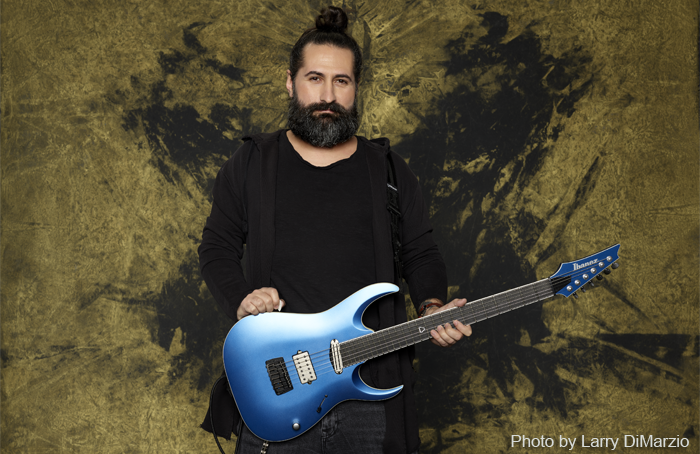
Conclusion
The Mirage set is going to be good for progressive rock, progressive metal, thrash, death metal, hardcore, hard rock, metal core, extreme metal, tech metal, classic rock, punk, hardcore, djent, nu-metal, and more rock styles.
For reference, this DiMarzio Mirage humbucker set pickup evaluation was conducted with a Fractal Axe-Fx II XL+ featuring Celestion Impluse Responses and Fractal MFC-101 MIDI Foot Controller. In addition, real cabs in use are Marshall 1960B, Mojotone British, and Peavey 6505 cabs loaded with Celestion Classic Series Vintage 30s and Classic Series G12M Greenbacks.
DiMarzio Website | Facebook | Twitter | YouTube | Instagram
Periphery Website | Facebook | YouTube | Instagram
Jake Bowen Website | Facebook | Twitter | Instagram | SoundCloud


